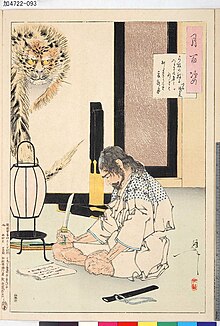Death poem

A death poem ( Japanese 辞世 の 句 , jisei no ku ) is a poem written by someone who is close to death . It is the custom in various cultures, including Japan , for educated people to write one.
description
Poetry has long been a core part of the Japanese tradition, closely related to religious practice. The poem should be elegant, natural and represent neutral feelings from the teachings of Buddhism or Shinto (and possibly Christianity ). With the exception of the earliest works in this tradition, it was considered crude to address the fact of dying directly. However, one can use undertones of words like sunset or falling cherry blossoms to suggest the inevitability of death.
It was customary to consult about this once-in-a-lifetime event beforehand, sometimes long before death, in order to draft a poem. Much changes in a person's life, and so the poems have often been rewritten. This rewriting was almost never mentioned in order not to tarnish the memory of the deceased.
Both Chinese and Japanese Zen - monks write death poems (either Chinese in poetry style ( Kanshi ) or Japanese style Waka or haiku ), as is the tradition for haiku poets and anyone who wishes to write one.
It is an old custom for educated people in Japan to write a jisei on the deathbed . One of the oldest jisei was recited by Prince Otsu before he was executed in 686 . Famous death poems are known from the haiku poet Bashō , the monk Ryōkan , the builder of the Edo Ōta Dōkan castle , and the wood- printing master Tsukioka Yoshitoshi .
Some poets left their death poems in several forms. Prince Otsu as Waka and Kanshi , the tea master Sen no Rikyū as Yuige ( 遺 偈 ) - Buddhist death poem - in Kanshi form and as Kyōka ( 狂歌 ) - satirical tanka.
The death poem sometimes had the side aspect of a will and reconciled differences between different people.
In a rule-based seppuku , one of the rituals is to write a death poem. This is written in the waka style. Asano Naganori , the daimyo whose suicide was avenged by the 47 Rōnin , wrote a poem in which commentators find a reference to immaturity and lack of character, which above all led to his being ordered to commit seppuku to restore his honor .
Examples
The death poem of Katsushika Hokusai has the form of a haiku :
| Japanese | transcription | translation |
|---|---|---|
|
ひ と 魂 で |
hitodama de |
As a ghost I will now |
The hitodama (literally: human soul ) leaves the body at the moment of death in the form of a pale blue fireball that remains near the home of the deceased for 49 days. The following poem was spoken by the monk Ryokan (1757–1831) to the nun who cared for him in his last moments:
| Japanese | transcription | translation |
|---|---|---|
|
う ら を 見 せ |
Ura o mise |
Sometimes it shows the back, |
Quotes
“In our country the Zen monks write death poems. Most of them compose the poem when they are still healthy and then when they die they pretend to write it spontaneously. Some of these poems are nonsense; others deserve the highest recognition. "
“Zen monks ... usually write death poems. I myself know of two or three monks who wrote their poems at the moment of death - a very difficult undertaking. They might think they were doing it for their students, but if you want to respect the course of nature, such a practice is by no means appropriate ... The motive for trying so hard to write a death poem is desire to make an impression on others. "
literature
- Yoel Hoffmann: Japanese Death Poems. Written by Zen Monks and Haiku Poets on the Verge of Death . Charles E. Tuttle Company, 1986, ISBN 0-8048-1505-4 , 366 pages (shortened German translation: The art of the last moment. Death poems of Japanese Zen masters . Herder, Freiberg, Basel, Vienna 2000, ISBN 3-451-04965- 1 , 160 pages)
